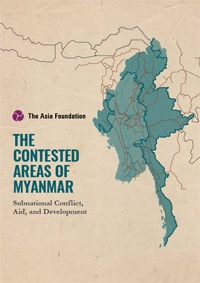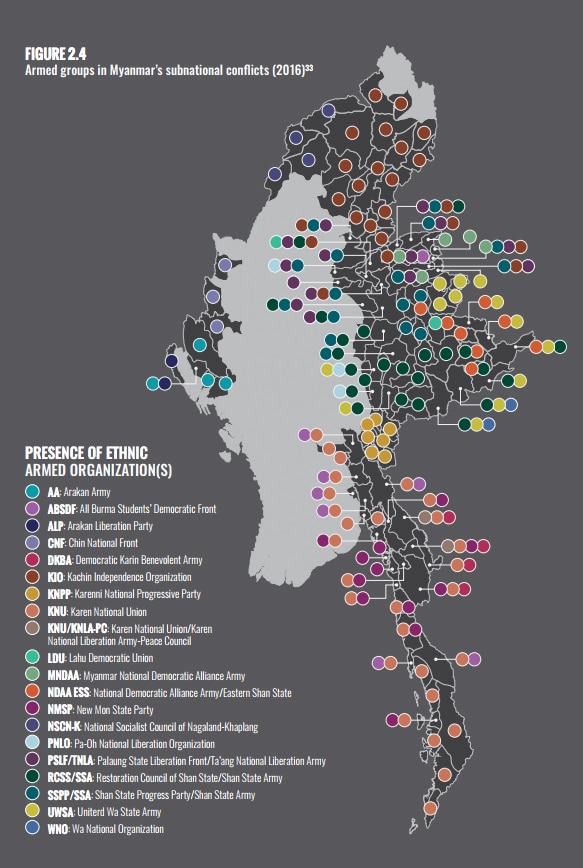October 18, 2017
 As Myanmar emerges from decades of authoritarianism and isolation, significant progress toward peace has been made since 2011. But heavy fighting and deadly clashes have intensified in many of the country’s contested areas, in particular Rakhine State, which has led to massive displacement, and Kachin and Shan States. These conflicts are among the world’s most enduring, posing significant challenges to national political reforms, economic growth, and human development, according to a study released yesterday by The Asia Foundation.
As Myanmar emerges from decades of authoritarianism and isolation, significant progress toward peace has been made since 2011. But heavy fighting and deadly clashes have intensified in many of the country’s contested areas, in particular Rakhine State, which has led to massive displacement, and Kachin and Shan States. These conflicts are among the world’s most enduring, posing significant challenges to national political reforms, economic growth, and human development, according to a study released yesterday by The Asia Foundation.
The year-long study, “The Contested Areas of Myanmar: Subnational Conflict, Aid, and Development,” comes at a pivotal moment amid longstanding conflicts in many parts of Myanmar, political dialogue to address the concerns of numerous ethnic groups, and a desire among international donors and aid agencies to support the peacebuilding process and the country’s political transition.
Findings from the study shed light on structural changes that are crucial for achieving sustainable and comprehensive peace in a country of great ethnic and cultural diversity. In addition, it reveals the intimate connections between subnational conflicts and national politics in Myanmar, instances where development interventions have contributed to uneven power dynamics and fueled armed resistance, and ways in which international aid can sometimes damage prospects for peace when initiatives are not sensitive to conflict. In this context, the study underscores a critical need to continue the ongoing political and economic reforms while building a system of government that is widely recognized as legitimate by people of all ethnic nationalities.
Below are some key findings from the study:
- Myanmar’s subnational conflicts are not a peripheral issue and directly affect much of the country
In 2016, areas affected by active or latent subnational conflict were found in at least 11 of Myanmar’s 14 states and regions. One hundred and eighteen of 330 townships, containing almost one-quarter of Myanmar’s population, currently demonstrate live or latent characteristics of conflict.

- Myanmar’s conflicts are not caused by underdevelopment
There is no simple correlation between human development, economic growth, and conflict in Myanmar, and subnational conflicts will not be resolved by measures to improve development outcomes. Conflict townships are on average only marginally less developed than non-conflict townships, particularly when Yangon is excluded. Some conflict townships exceed national averages, while others have the lowest development indicators in the country. - Tackling underdevelopment alone will not create peace
Development interventions alone can never lead to peace. Myanmar’s conflicts are inherently political and connect to the structure of the state. Political solutions are, therefore, required to solve subnational conflict. Given the complex nature of Myanmar’s armed conflicts, interventions and policies should be strengthened to address the underlying drivers of conflict and be more responsive to the power inequities that have driven conflict over years, especially during transitional political periods. - Development policies can drive subnational conflict
In many contested areas, economic changes and increased natural resource exploitation have ratcheted up tensions, engendered rivalries, fueled grievances, and provided funds that have sustained conflict. Foreign assistance can sometimes be manipulated to serve security objectives, particularly where government officials or leaders of ethnic armed organizations are able to decide project locations. In short, development interventions are never neutral. - Aid can build momentum for peace as well as damage the prospects for peace
Projects that serve the security aims of one side can damage the confidence of ethnic groups in the country’s transition, while programs that support political reforms, such as decentralization, can help build momentum. $13.7 billion in aid was committed to new projects between 2011 and 2015. Closer alignment of donors with government offers advantages in coverage, cost effectiveness, and sustainability, but it also poses risks for peace.
The article appeared in the Asia Foundation newsletter on 18/10/2017
